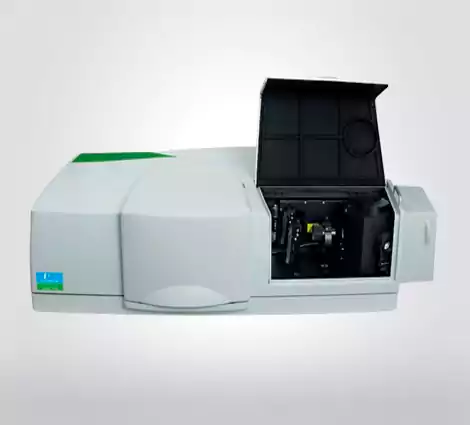 UV/Vis spectrophotometers are usually dual-beam spectrophotometers where the first channel contains the sample and the second channel holds the control for correction. A spectrophotometer has two fundamental parts: a source of radiant light and a monochromator. Monochromator is placed between the light source and the sample which disperses the radiant energy into a spectrum. A slit is also fixed which selects a narrow portion of the spectrum. The standard cell or cuvette is placed in a light-tight-unit. The incident light strikes the standard cell and emergent light passes into a photocell. The photocell changes the emerging light energy into measureable electrical energy.
UV/Vis spectrophotometers are usually dual-beam spectrophotometers where the first channel contains the sample and the second channel holds the control for correction. A spectrophotometer has two fundamental parts: a source of radiant light and a monochromator. Monochromator is placed between the light source and the sample which disperses the radiant energy into a spectrum. A slit is also fixed which selects a narrow portion of the spectrum. The standard cell or cuvette is placed in a light-tight-unit. The incident light strikes the standard cell and emergent light passes into a photocell. The photocell changes the emerging light energy into measureable electrical energy.
Applications
- Qualitative analysis and quantitative determination of UV/Vis active analytes, namely, organic compounds, biological macromolecules, etc.
- Drug identification and nucleic acid purity checks and quantitation, to quality control in the beverage industry and chemical research, etc.
Instrument Specifications
- Make: PerkinElmer
- Model: Lamda 650
Technical Details
- Double beam
- Wavelength range (190-900nm)
- Light source: Deuterium- Tungsten Halogen lamp
- Detector: Photomultiplier tube
- Software: UV Win lab Double beam
Sample Requirement
Solid: ~50 mg (powder), Thin film: 1.0-1.5 cm, Solution: ~5 ml. Solvent must be specified for solution studies.
Instructions
- Any kind of solid sample, powdered samples and thin films can be analyzed but avoid carcinogenic/corrosive/ infectious material/highly acidic or alkaline samples which may affect the optical components.
- Samples should be homogeneous and well packed in the sample holder so that it will not spill out and fall on the lens.
Analytical Charges
- KSCSTE Labs: Rs.61.00
- Edu. Insti.: Rs.121.00
- Govt R&D Labs: Rs.242.00
- Industries: Rs.363.00
Notes:
- Rates for sample analysis, Service tax -18 % extra.
 CAI-K
CAI-K